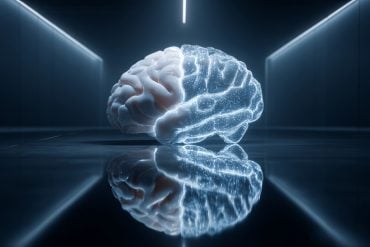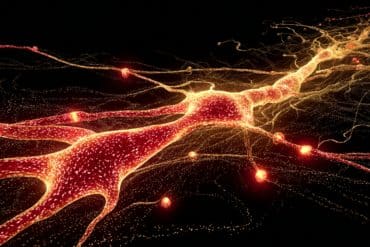Summary: Researchers upgraded BARseq to map millions of neurons, enhancing our understanding of brain connections. This advanced technique reveals how losing vision changes the visual cortex, making it more like neighboring brain areas.
These insights can inform treatments for conditions like Alzheimer’s and schizophrenia. The study showcases BARseq’s potential to revolutionize neuroscience.
Key Facts:
- BARseq maps millions of neurons, identifying cells by their gene expression and tracing neural circuitry.
- Loss of vision alters the visual cortex, making it resemble neighboring brain areas.
- This research advances treatment strategies for brain disorders by understanding neural connections.
Source: CSHL
Understanding the connections between different brain areas could pave the way to better treatment strategies for conditions like Alzheimer’s, schizophrenia, and depression.
In 2019, as a postdoc in Cold Spring Harbor Laboratory’s (CSHL’s) Zador lab, Xiaoyin Chen helped develop a technique to map these connections. BARseq identifies cells in the brain by the genes they use and traces the connecting neural circuitry. Early versions of BARseq mapped gene expression across thousands of neural pathways, using “barcodes” or short snippets of RNA.

Chen is now an assistant investigator at the Allen Brain Institute. He recently reunited with CSHL Professor Anthony Zador to upgrade BARseq’s capabilities. What does that look like? Instead of thousands of neurons, BARseq can now map millions.
“We are focused on pushing BARseq forward. We want to make this easy for everybody to use, faster, more sensitive. Can we read out more information with it? With much higher scale, you can start to answer different questions,” says Chen.
The team began their search for answers in the brain’s visual cortex. Sight is one of the most common ways humans perceive the world. Information travels from the eyes to the visual cortex for processing. But what happens in the brain when the visual cortex’s neural inroads are cut or don’t form at all?
“People have known for a while that visual inputs are very important in shaping the brain,” Chen explains. “But we don’t know, at the exact cell-type resolution BARseq provides, what actually happens.”
The team used BARseq to map the brains of nine mice and traced gene expression in each mouse’s visual cortex. It’s the first time the technique has been used to map this many entire brains. Amazingly, the team found that if the mice went blind, the genes in the visual cortex started to look like those in neighboring cortical areas of the brain.
“The effects of losing vision were very broad,” Chen explains. “The visual cortex itself changes. It becomes more similar to the areas around it. There are still a lot of questions about how development controls this patterning.”
Chen is now working to expand BARseq’s capabilities even further. He and his team are using the technique to investigate how connections are wired in developing brains and how these connections evolve.
“Understanding how cortical areas are set up is the first step in understanding these connections,” he says. “But it’s not enough. We still need to discover how they progress during development. BARseq can bring us closer to that goal.”
About this neuroscience and brain mapping research news
Author: Sara Giarnieri
Source: CSHL
Contact: Sara Giarnieri – CSHL
Image: The image is credited to Neuroscience News
Original Research: Open access.
“Whole-cortex in situ sequencing reveals input-dependent area identity” by Xiaoyin Chen et al. Nature
Abstract
Whole-cortex in situ sequencing reveals input-dependent area identity
The cerebral cortex is composed of neuronal types with diverse gene expression that are organized into specialized cortical areas. These areas, each with characteristic cytoarchitecture, connectivity and neuronal activity, are wired into modular networks.
However, it remains unclear whether these spatial organizations are reflected in neuronal transcriptomic signatures and how such signatures are established in development.
Here we used BARseq, a high-throughput in situ sequencing technique, to interrogate the expression of 104 cell-type marker genes in 10.3 million cells, including 4,194,658 cortical neurons over nine mouse forebrain hemispheres, at cellular resolution. De novo clustering of gene expression in single neurons revealed transcriptomic types consistent with previous single-cell RNA sequencing studies.
The composition of transcriptomic types is highly predictive of cortical area identity. Moreover, areas with similar compositions of transcriptomic types, which we defined as cortical modules, overlap with areas that are highly connected, suggesting that the same modular organization is reflected in both transcriptomic signatures and connectivity.
To explore how the transcriptomic profiles of cortical neurons depend on development, we assessed cell-type distributions after neonatal binocular enucleation.
Notably, binocular enucleation caused the shifting of the cell-type compositional profiles of visual areas towards neighbouring cortical areas within the same module, suggesting that peripheral inputs sharpen the distinct transcriptomic identities of areas within cortical modules.
Enabled by the high throughput, low cost and reproducibility of BARseq, our study provides a proof of principle for the use of large-scale in situ sequencing to both reveal brain-wide molecular architecture and understand its development.






